Roads and Road Repair
Roads were typically not in an adequate condition for
the traffic that they had to take, and Signal Corps photos well
document the work
that was done to bring them up to a higher standard. Solid rubber
tires absorbed little road shock, so trucks were built heavily, which,
in turn, stressed roads even more. Speeds over 10 mph heated and
damaged solid tires, which lacked tread because tread created
heat. The alternative, air-filled pneumatic tires, suffered
frequent flats from horseshoe nails dropped on the road and were not
suitable as a result.
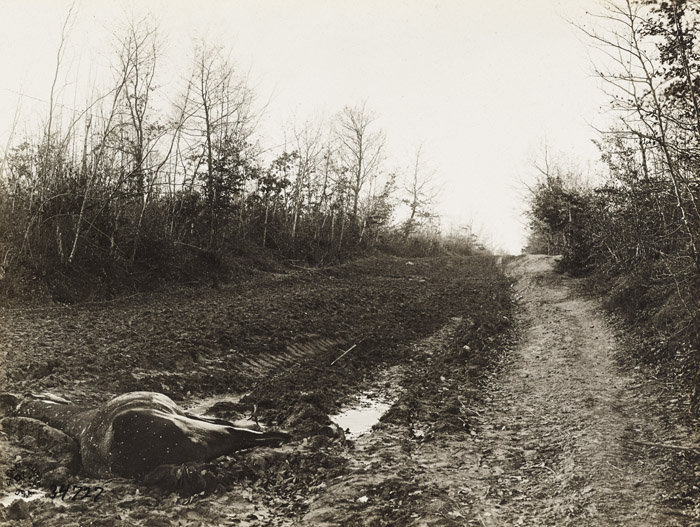
Typical Argonne road. The American advance necessitated the
heaviest truck traffic for food and ammunition, at times over roads like these.
Many roads had to be rebuilt and metaled while the traffic was at its
height and while under German shell fire. Bois SW Bouzon, 2 1/2
km southwest from Montblainville.
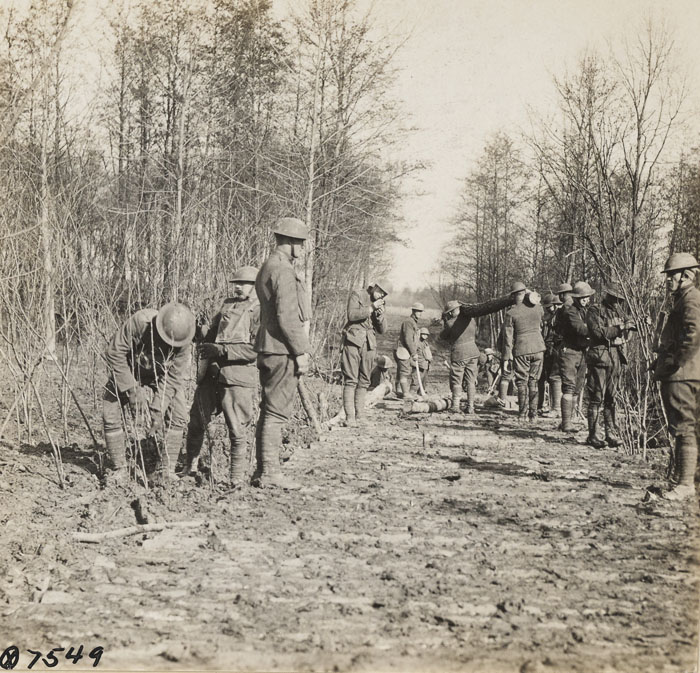
American engineers building corduroy road for supplying front line under indirect fire of enemy machine guns at Blemiercy.
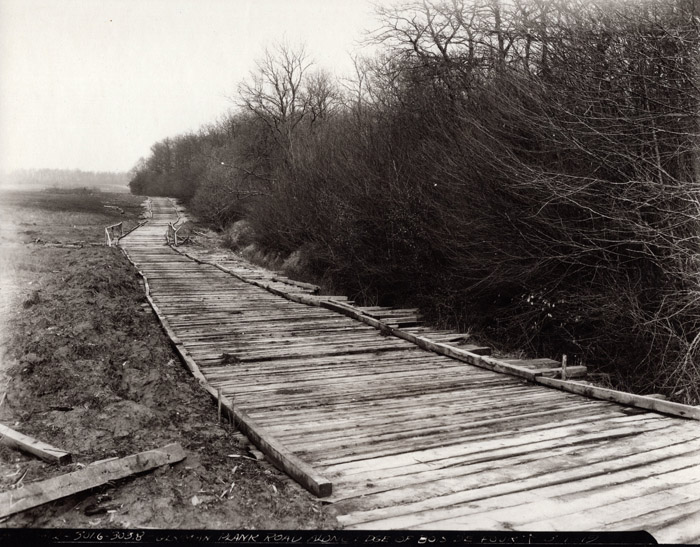
German Plank Road
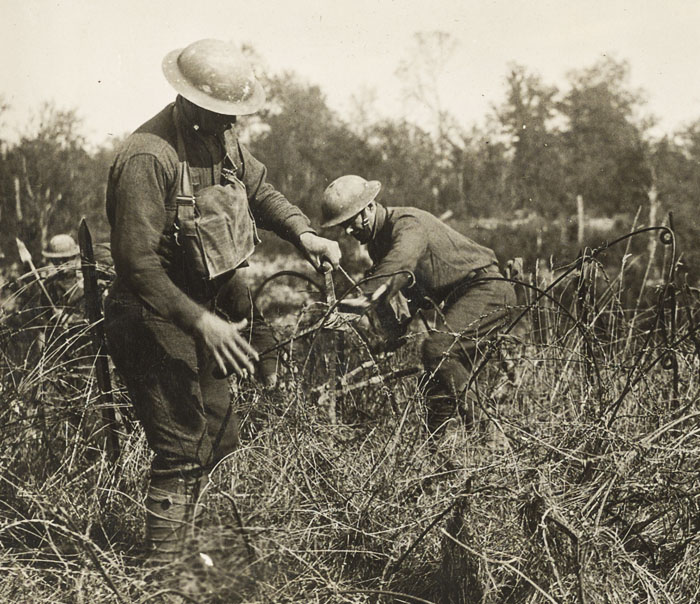
A detachment of the 107th Engineers, 32nd Div attached to the 5th Army
Corps clearing off wire entanglement from field in order to make way
for a road. Cheppy Road near Vauquois mountain. Oct 2, 1918
11:30am.
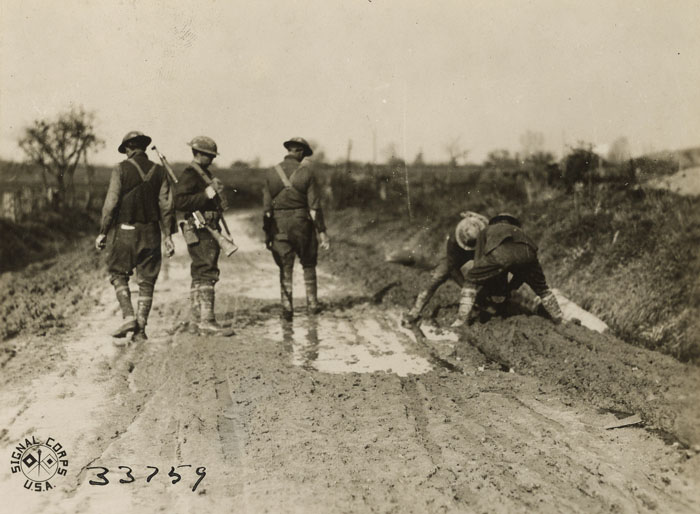
307th Engineers picking up dud hand grenades and shells from the mud on
the road. Vehicles running over the duds are liable to jog them
into concussion. Near Briquenay.
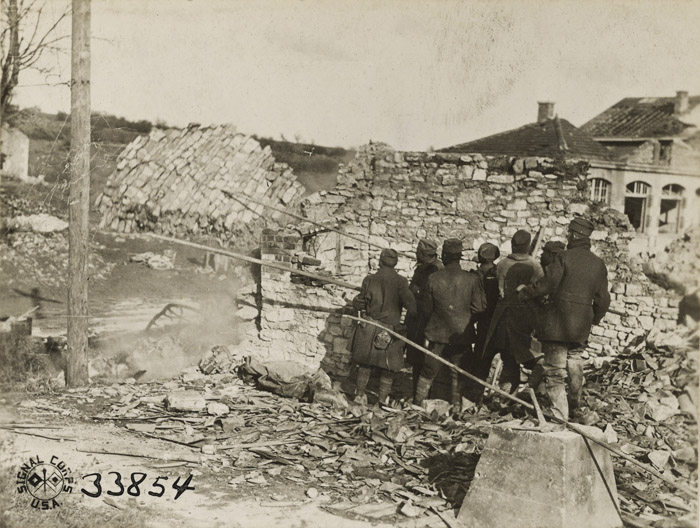
Co D, 544th Eng tearing down walls in Nantillois for road work.

Quarried showing Indo-Chinese at work breaking stone to be used for building roads at Hospital Camp, Mars sue Allier.

Indo-Chinese laborers loading the trucks with broken stone taken from the quarries. mars sur Allier.
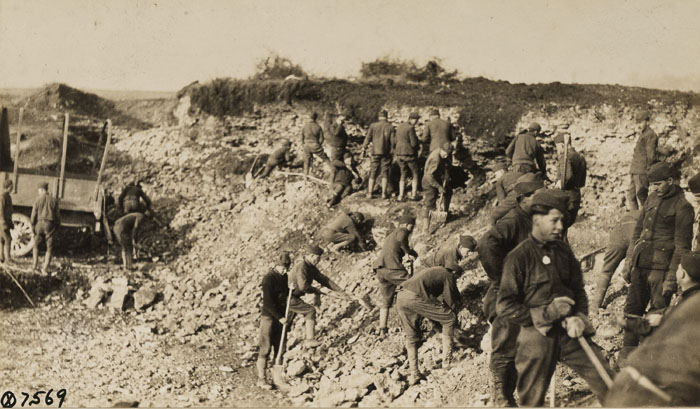
First Engineers, First Division, quarrying rock for a military roads, destroyed by German shells, Menil-la-Tour.
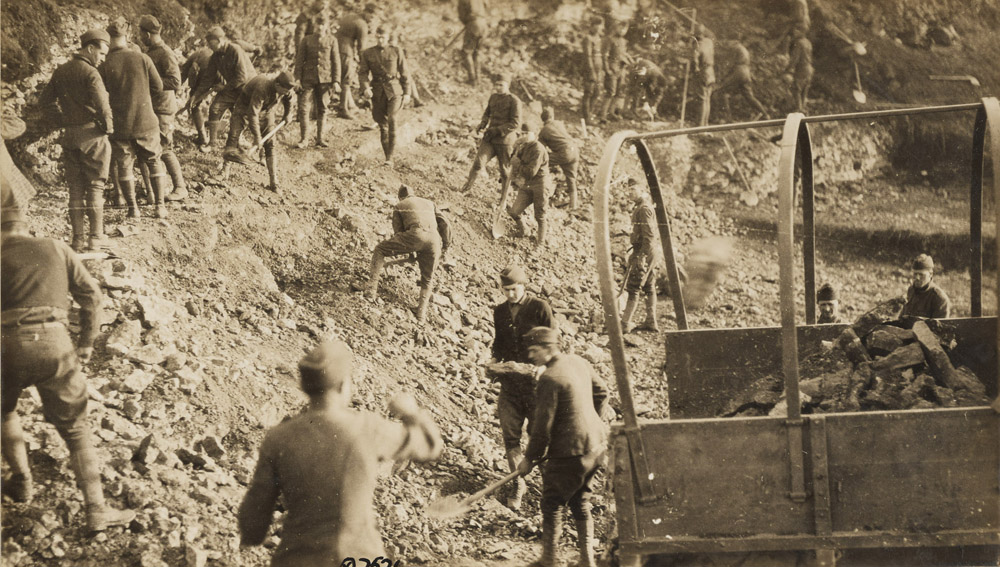
American engineers quarrying stone to repair military roads destroyed by German shells, Menil-la-Tour.
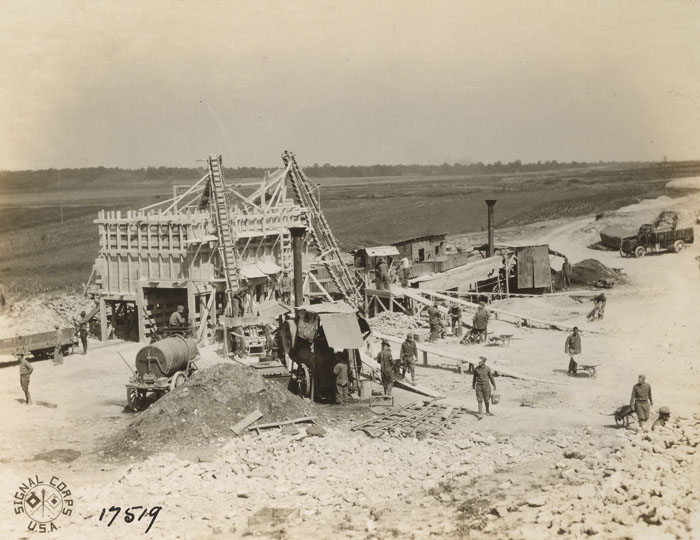
Quarry for road material. Department of Light Railways and Roads. Royoumouix, France.
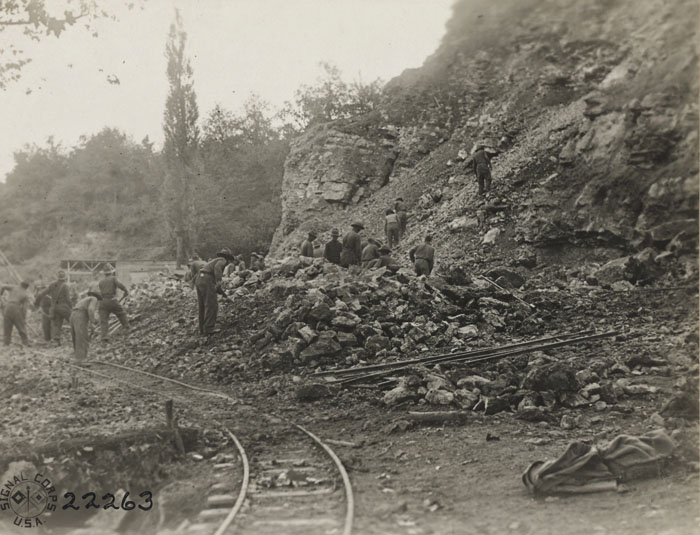
Cpt JA Killian, Commanding Co E, 28th Engineers. American
engineers getting rock from a French quarry for French road using
American engineering equipment. Ingersoll Rand Steam Drill;
Farquar Steam Engine made at York, PA, Western Rock Crusher, made by
Western Wheel Scrapper Co. Aurora, IL, USA. Near Diolard, France.
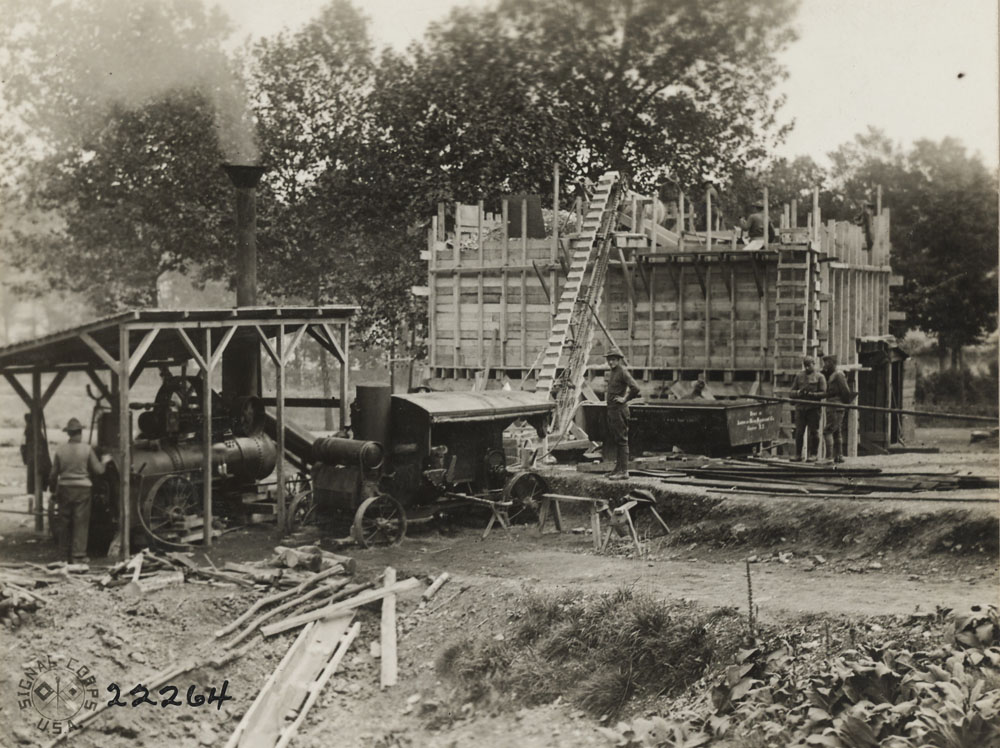
Cpt JA Killian, Commanding Co E, 28th Engineers. American engineers
getting rock from a French quarry for French road using American
engineering equipment. Ingersoll Rand Steam Drill; Farquar Steam
Engine made at York, PA, Western Rock Crusher, made by Western Wheel
Scrapper Co. Aurora, IL, USA. Near Diolard, France.
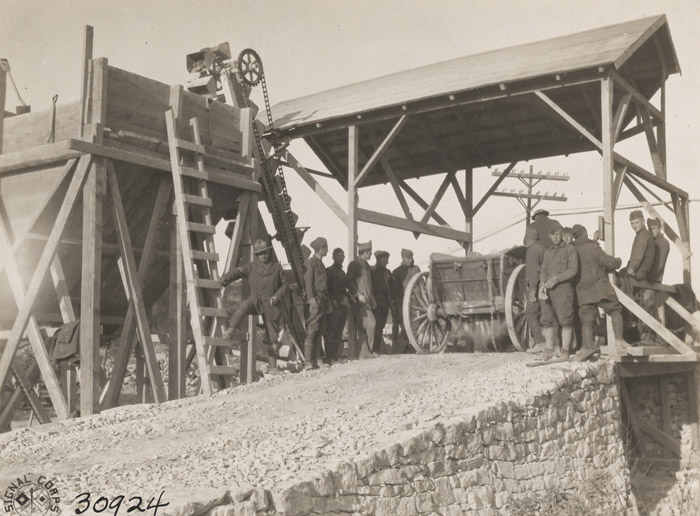
View of the stone crusher used by the 23rd Eng. The stones are
crushed and used to rebuild the roads. Avocourt. Oct 30,
1918.
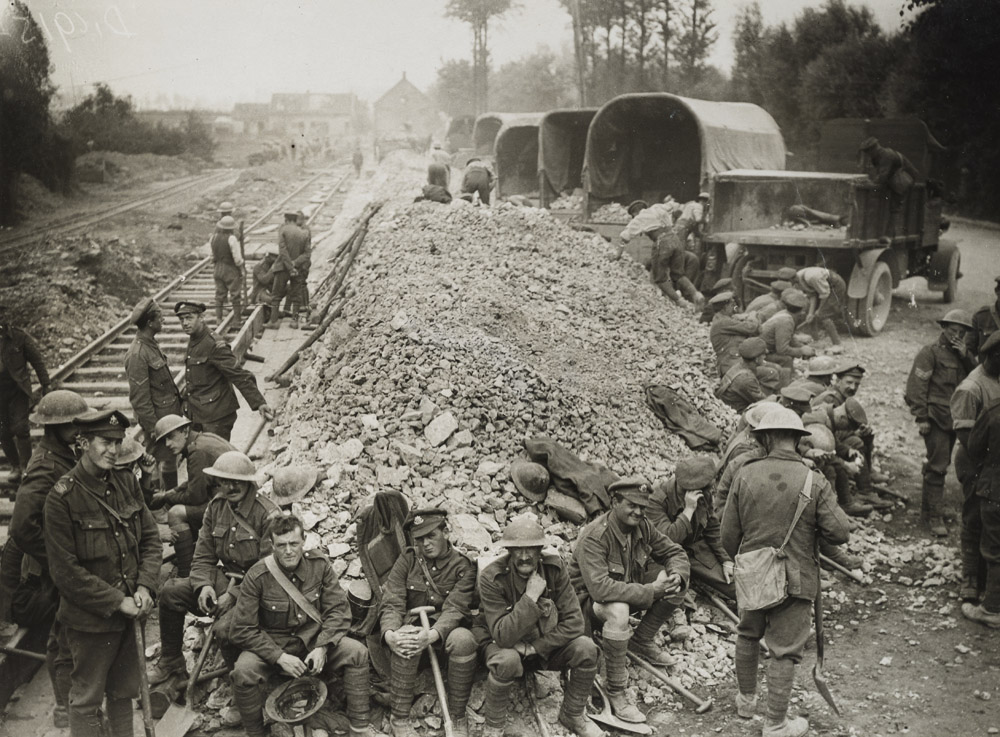
Stones for road repairs, British Western Front.
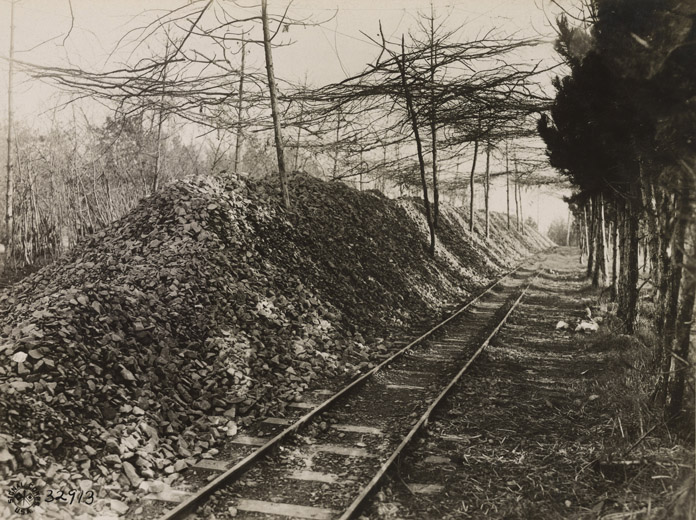
Rock crushed by the German. Pile is half a mile long and is 25
feet wide by 20 feet high; used by the Americans for road work and
repairing railroad beds. Top of Mt two miles south of Heudicourt
on road to St Mihiel.
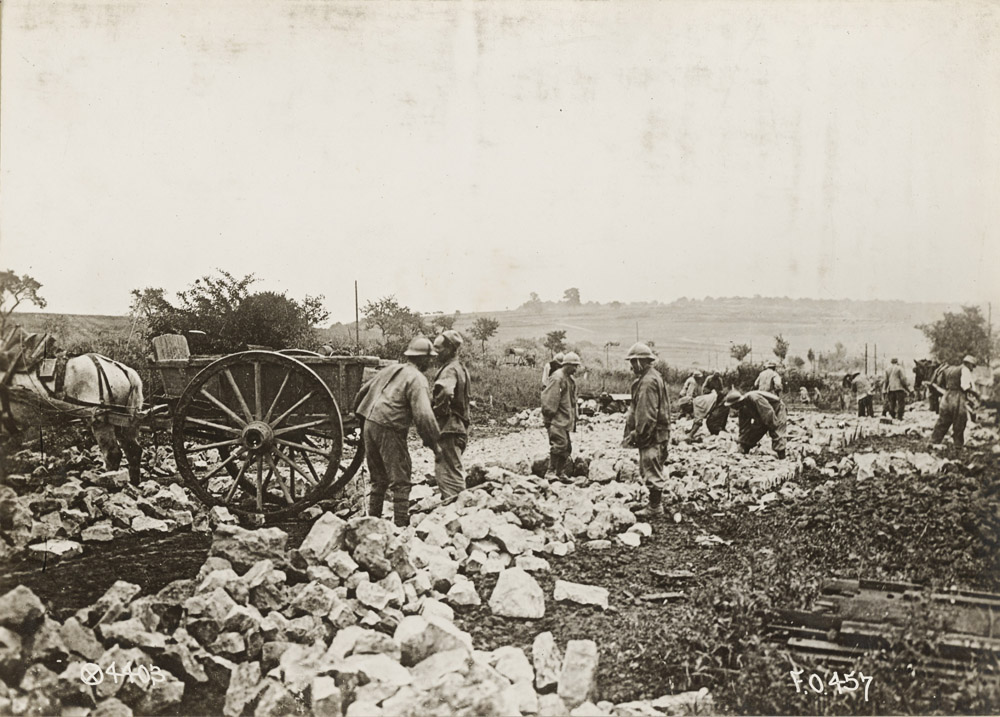
French soldiers laying stone for the base of a new railroad in the
Meuse district, which will connect the supply depot with the front line
trenches. This work was afterwards taken over by American
Engineers with German prisoners doing the manual labor.
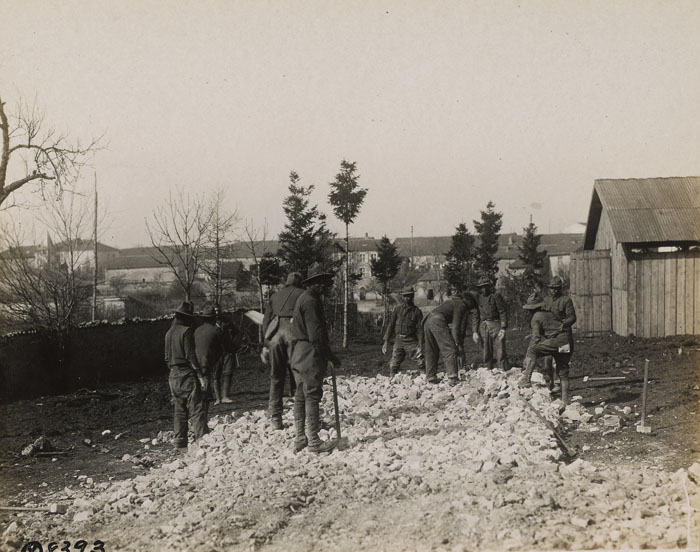
508th Engineers, Co C, building roads, Menil-la-Tour, March 14, 1918
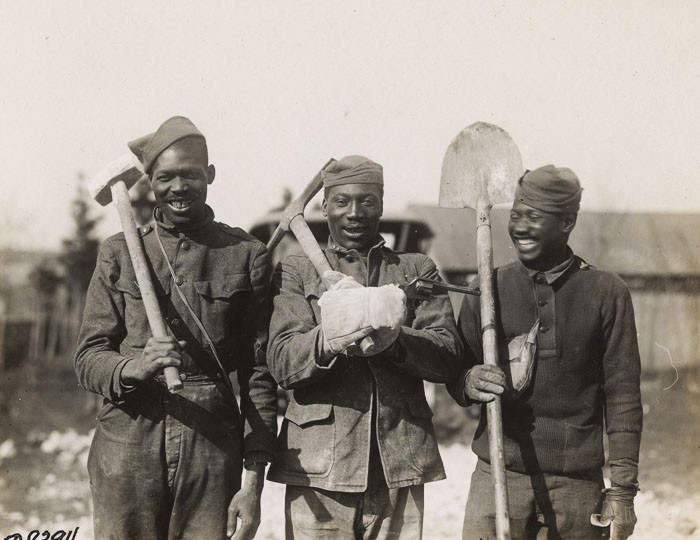
Three members of Co C, 508th Engineers, Menil-la-Tour
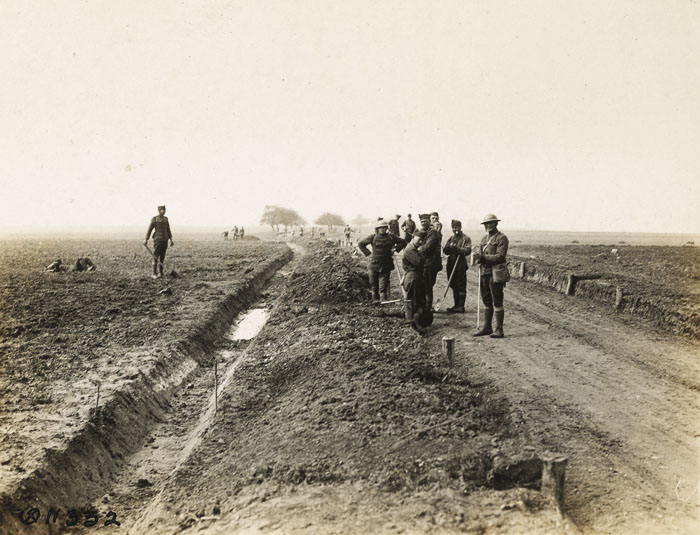
1st Engineers, draining and repairing road under shell fire, near Broyes, May 2, 1918.
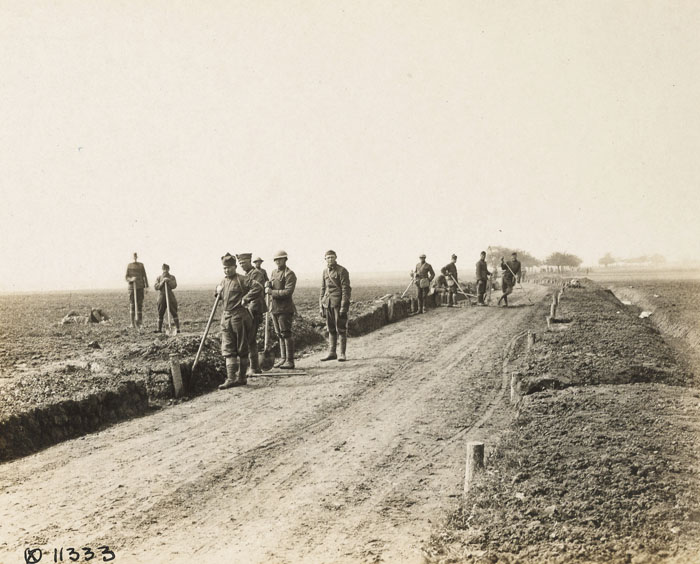
1st Engineers draining and repairing road unders hell fire, near Broyes.
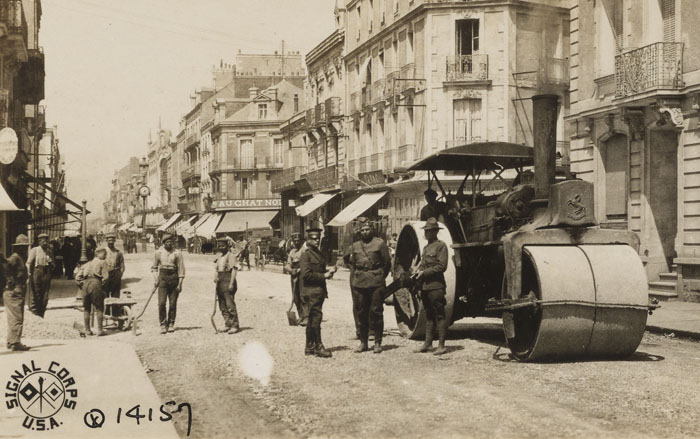
American engineers repairing street in city of St Nazaire.
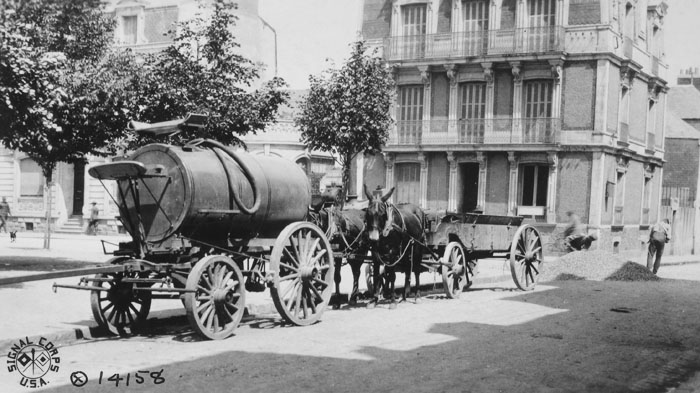
American engineers repairing street in city of St Nazaire.
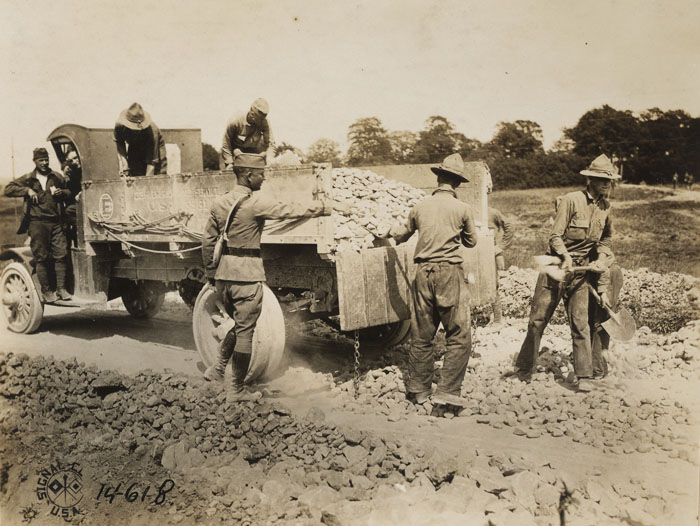
Members of Co C, 23rd Engineers unloading stone from truck. Camp de Gerard Sas, June 6, 1918
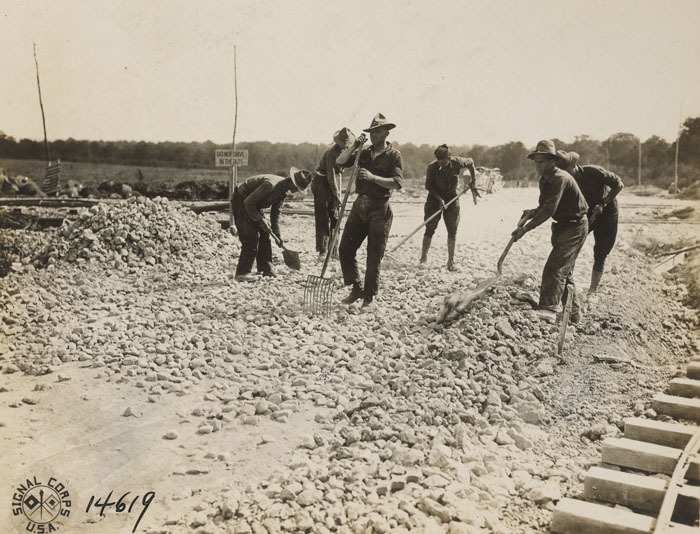
Members of Co C, 23rd Engineers spreading stone over road. Camp de Gerard Sas.
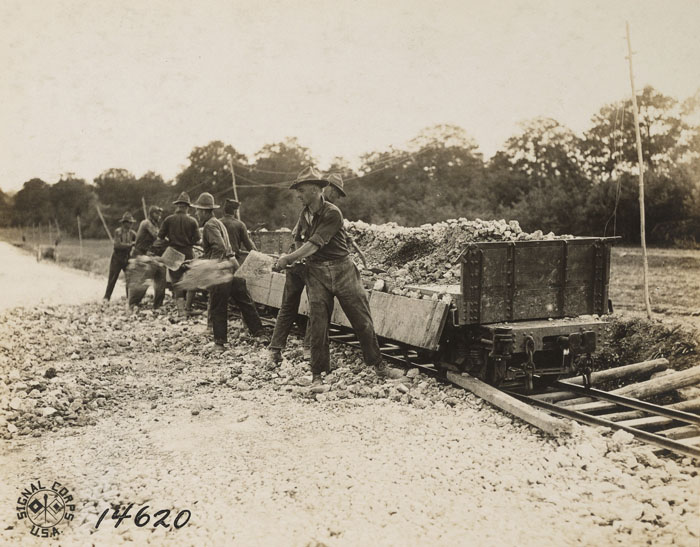
Members of Co C, 23rd Engineers, unloading two carloads of stone. Camp de Gerard Sas.
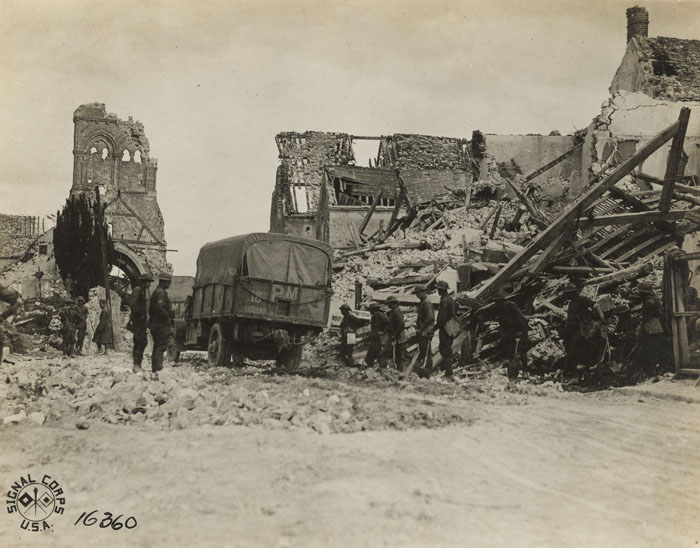
Members of Co D, 30th Engineers, clearing road of devris in Torcy. Ruined church in background.
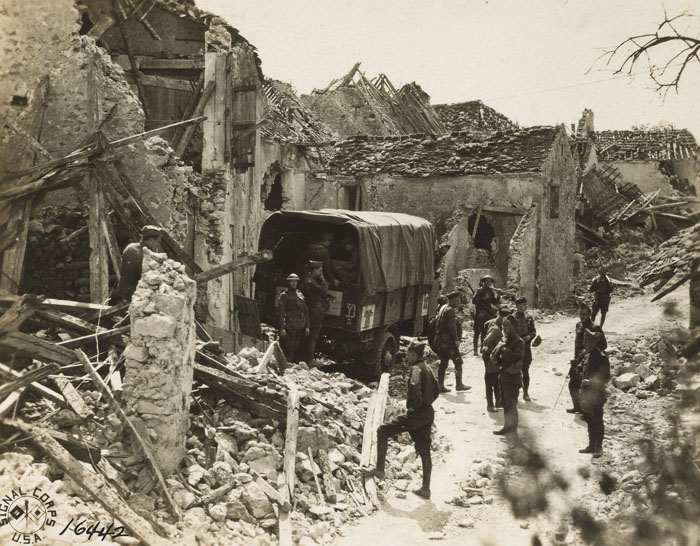
Headquarters Troop, 26th Division, making passage way for trucks. Lucy, France. July 20, 1918.
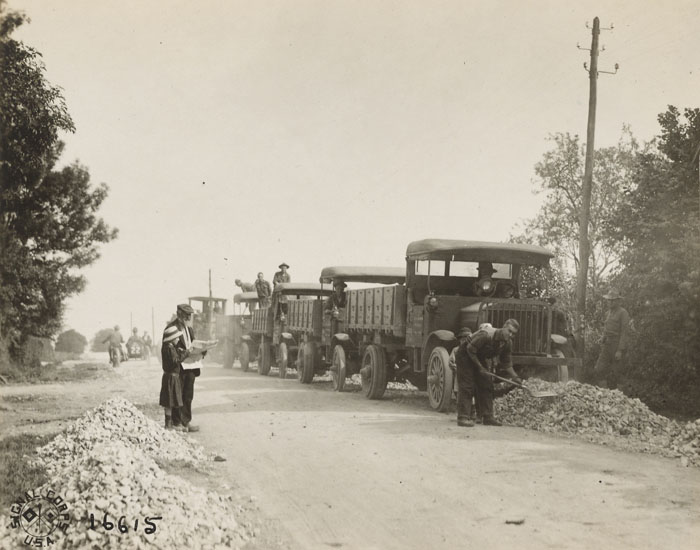
Members of 23rd Regiment Engineers repairing roads at Aviation Field #8, Issoudon, France, May 29, 1918.
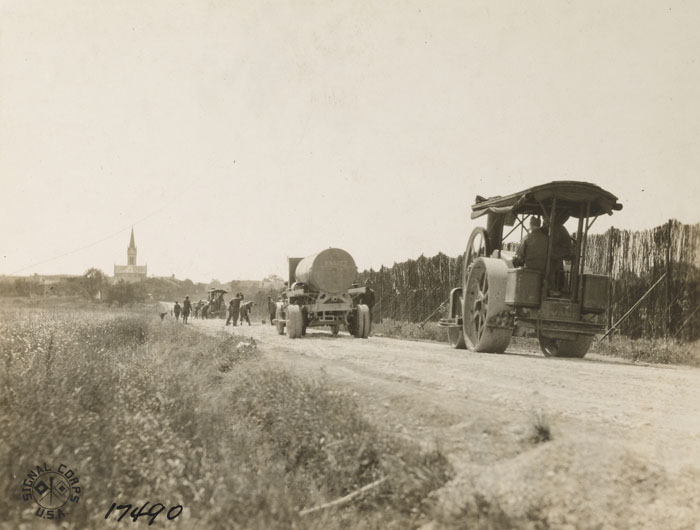
Building a road behind a camoflaged screen. Department of Light Railways and Roads. Raulecourt, France.
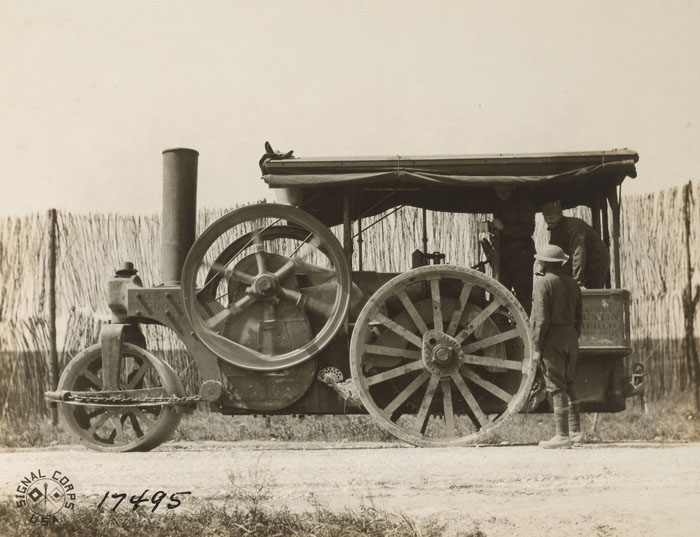
Gasoline road roller behind camoflaged screen. Department of Light Railways and Roads. Raulecourt.
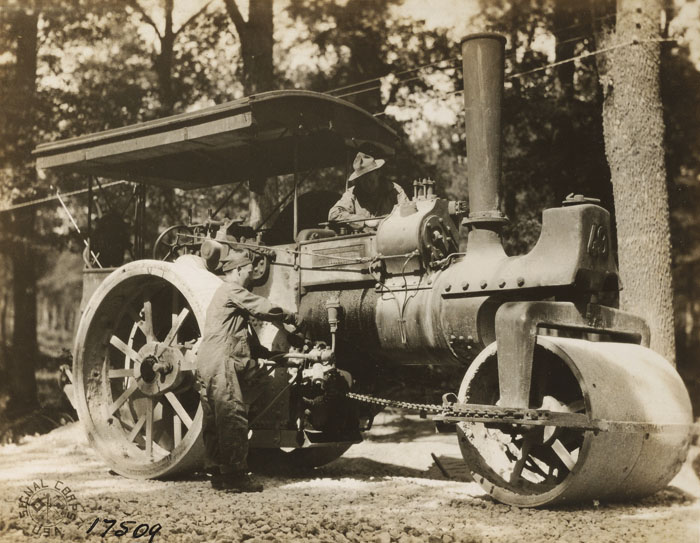
Steam road roller, Pvt McCarthy, Co C, 23rd Engineers, in foreground.
Department of Light Railways and Roads. Pond D'Esse.
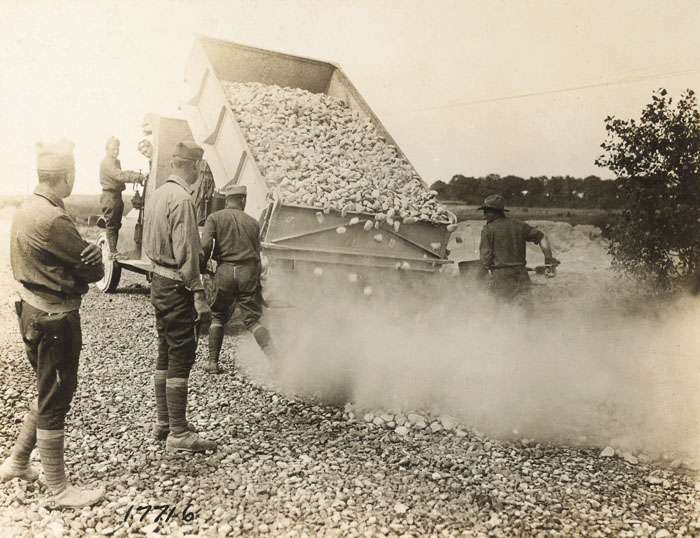
Members of 101st Engineers, 26th Division, building road. Raulecourt.

Members of 101st Engineers, 26th Division, building roads and crushing with steam roller. Raulecourt.
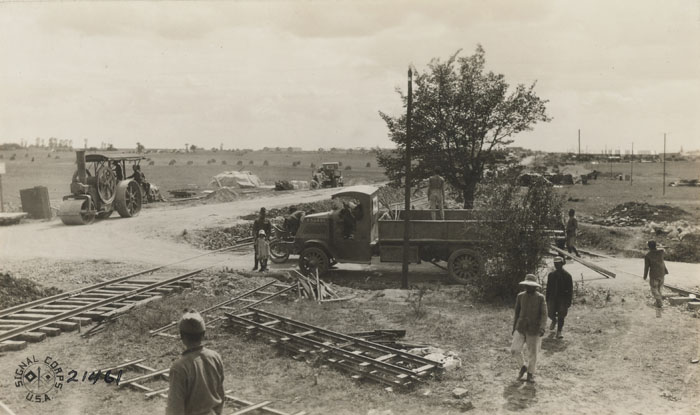
Auto and steam roller used in road building. Mars-sur-Allier Hospital.
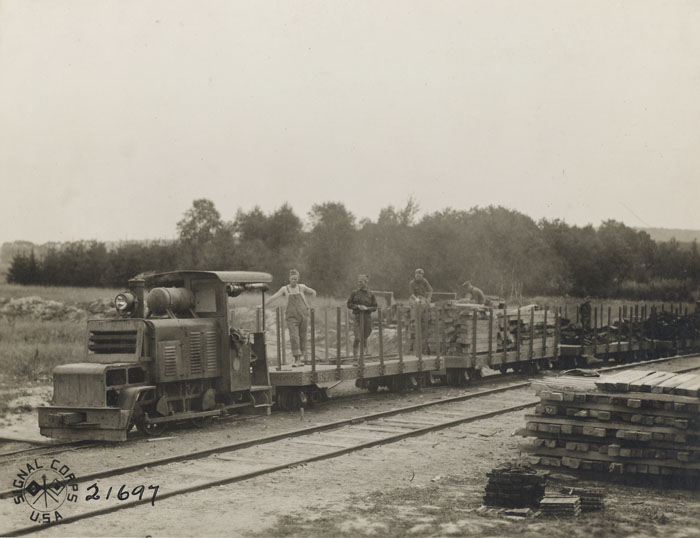
Supply train of the 12th Engineers loaded with material for the
construction of a new road at Roharrey. Between Baccarat and
Azerailles.
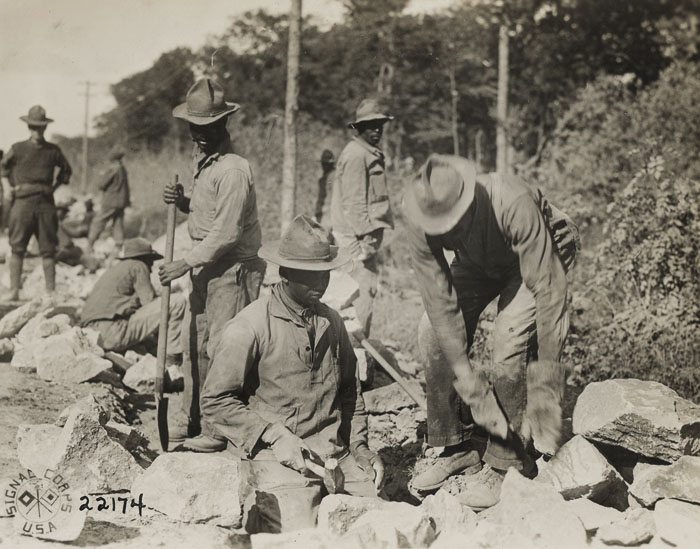
308th Engineers widening, ballasting and underdraining the roads. Near Roucq.
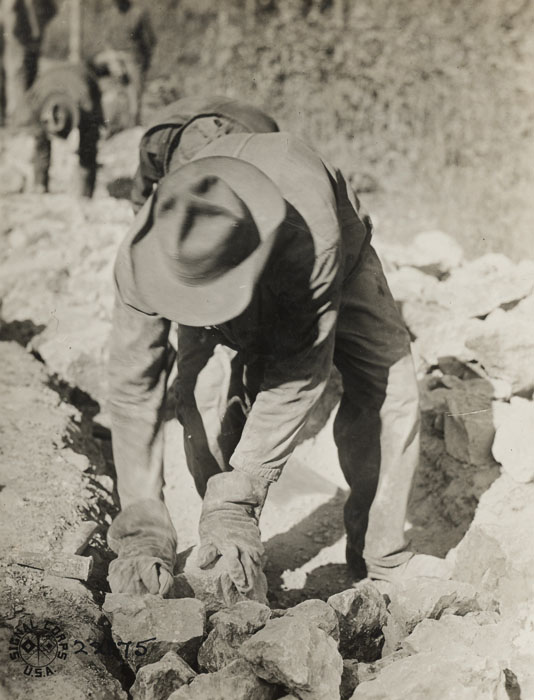
308th Engineers widening, ballasting and underdraining the roads. Near Roucq.
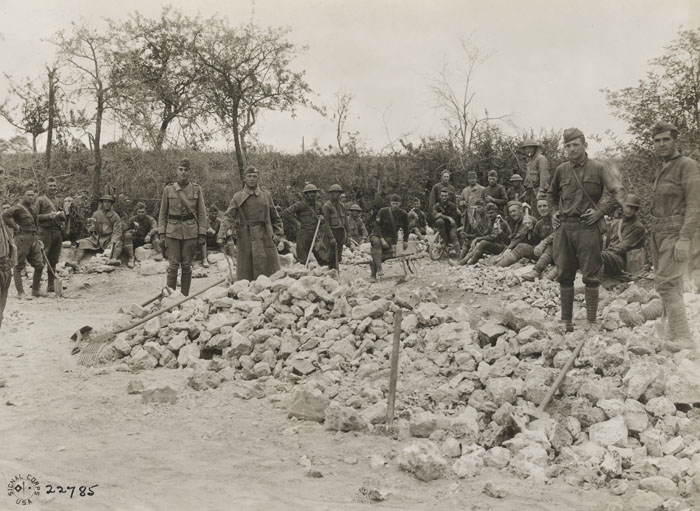
A group of American soldiers working on the road near Sergy, France.
Cpt EK Miller 1st Pioneer Inf and Lt CR Bliss 308th Engineers.
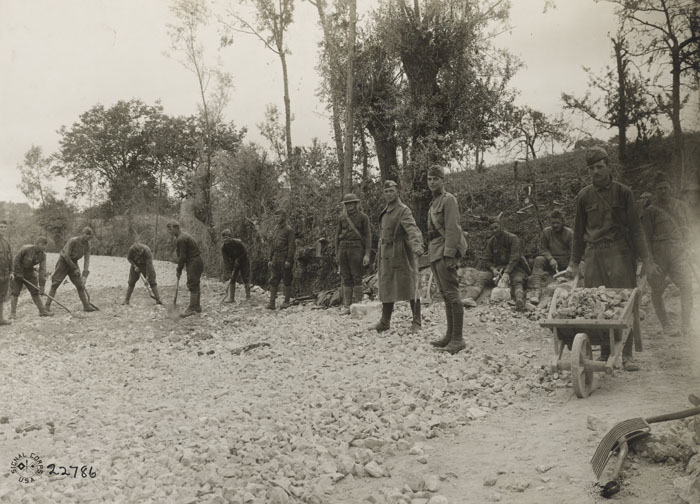
Showing how the small stones are wheeled onto the road with
wheelbarrows. Cpt Ed. K Miller 1st Pioneer Infantry and Lt CR
Bliss 308th Engineers are shown in this picture. Sergey, France.
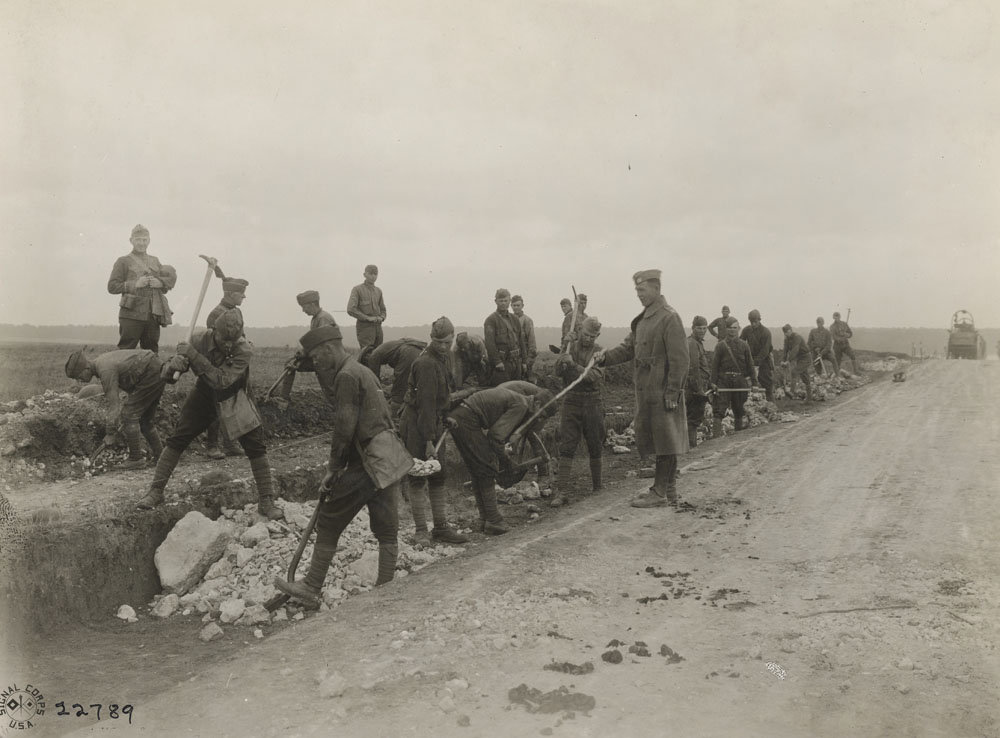
Making a two way road out of a one way road. Cpt EK Miller and
two of his assistants, Lts JJ Hall and PW Mengel. The work at
this point was started under great dificulties and was subjected to
almost continual shelling and aerial bombing by the Germans.
Sergy, France.
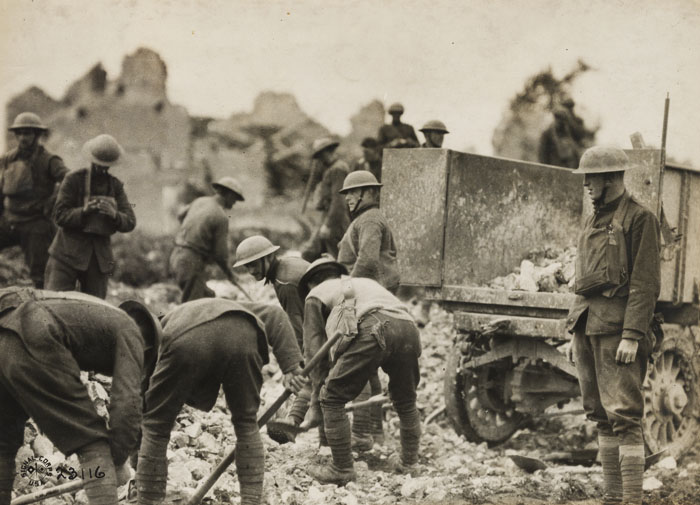
Members of the 315th Engineere assisted by men of the 357th and 358th
Inf under the direction of Lt LJ Burke, building a road over what was
No Man's Land a week before. The stones from tottering walls of
buildings is broken into smaller pieces and laid on the road bed making
a good military road. Fay en Haye.
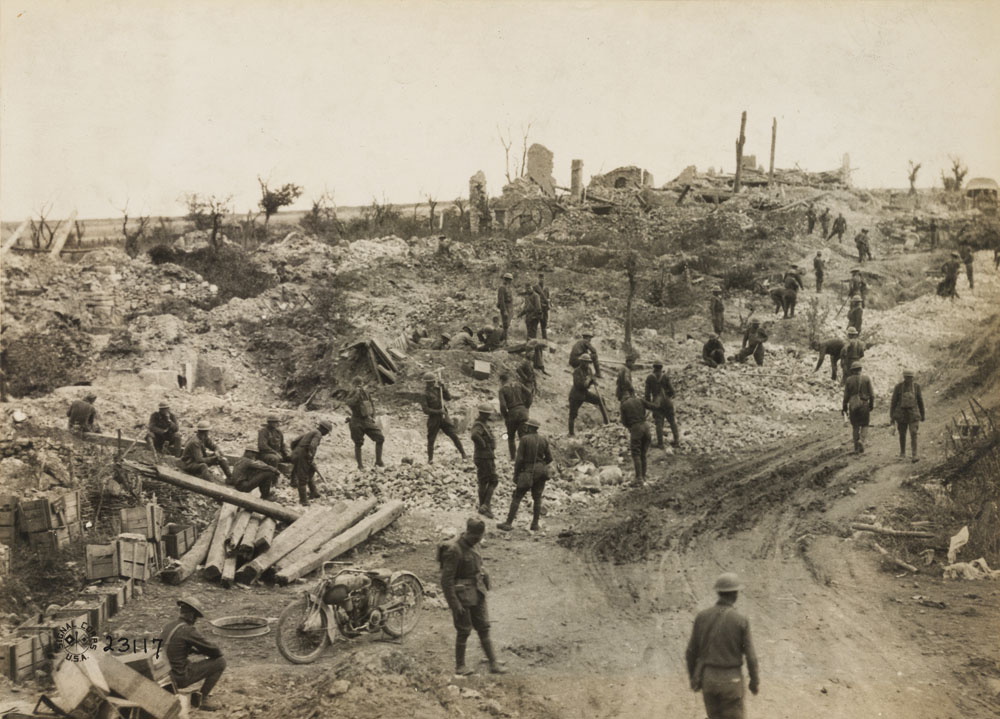
Members of the 315th Engineers assisted by men of the 357th and 358th
Inf under the direction of Lt LJ Burke, building a road over what was
No Man's Land a week before. The stones from tottering walls of
buildings is broken into smaller pieces and laid on the road bed making
a good military road. Fay en Haye.
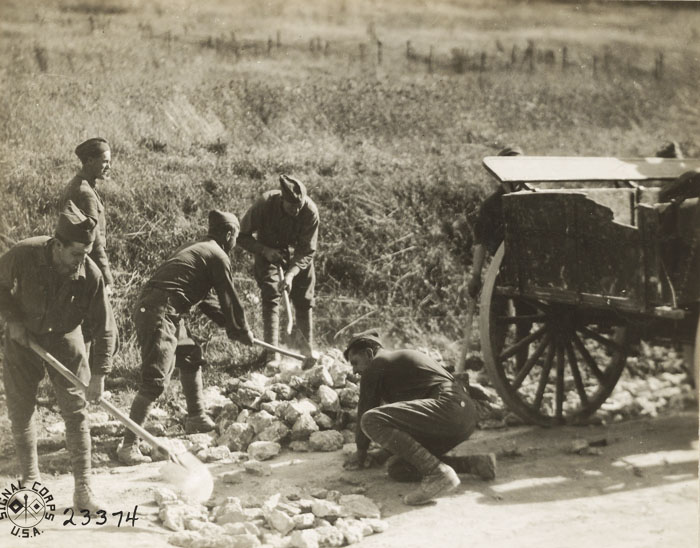
Men of Co C 1st Engineers who went over the top at Mont Sec repairing shell holes made by American Artillery. Mont Sec.
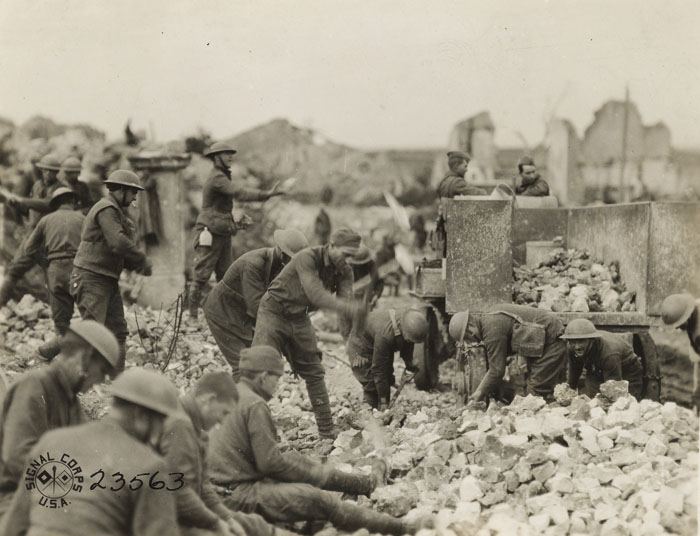
Members of the 315th Engineere assisted by men of the 357th and 358th
Inf under the direction of Lt LJ Burke, building a road over what was
No Man's Land a week before. The stones from tottering walls of
buildings is broken into smaller pieces and laid on the road bed making
a good military road. Fay en Haye.
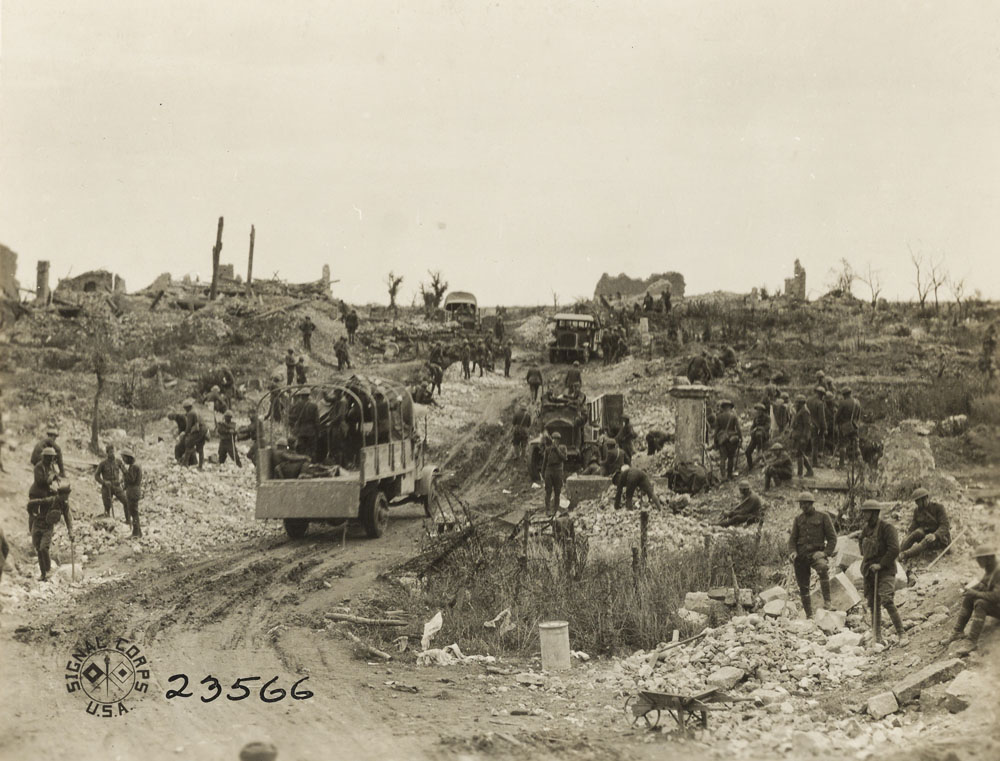
Members of the 315th Engineere assisted by men of the 357th and 358th
Inf under the direction of Lt LJ Burke, building a road over what was
No Man's Land a week before. The stones from tottering walls of
buildings is broken into smaller pieces and laid on the road bed making
a good military road. Fay en Haye.
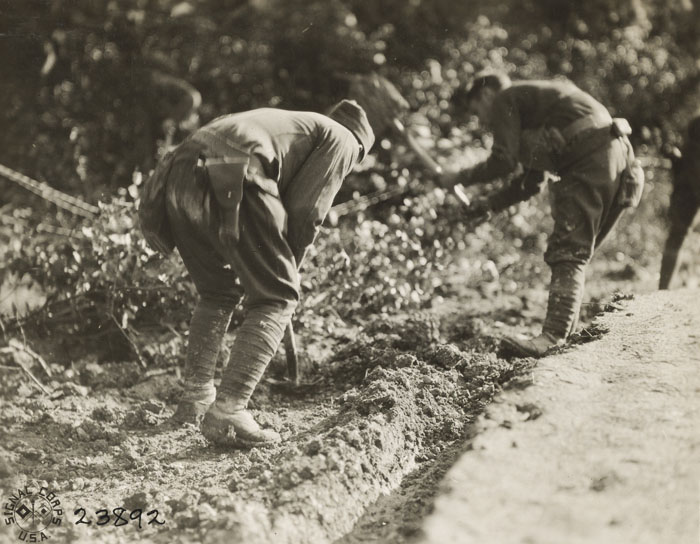
Artillery volunteers doing engineer road repairing. 109th Field Artillery, 28th Division. Region of Boureuilles.
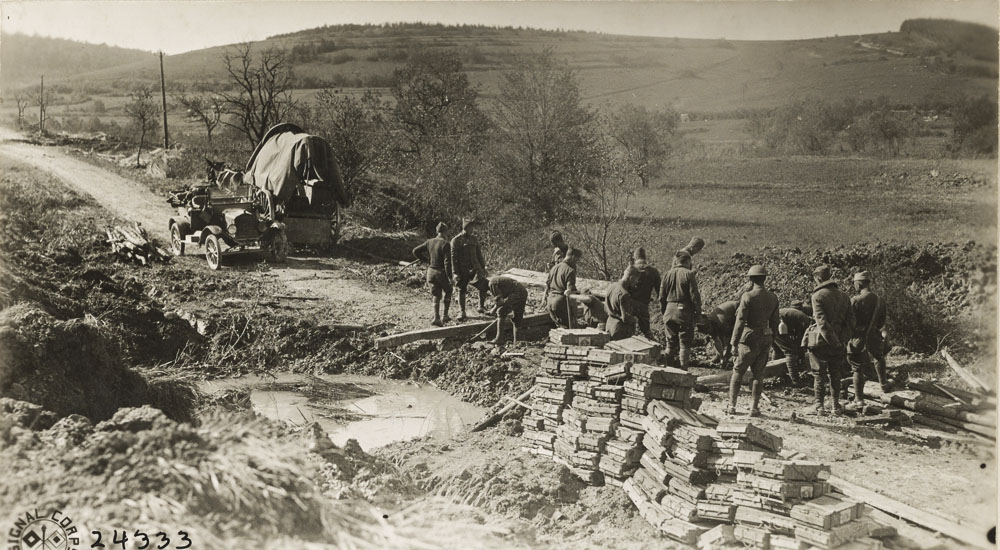
Members of 101st Regt Engineers, 26th Division, Commanded by Cpt EM
Brush, filling in shell hole on road made by American Artillery in the
advance of Sept 13, 1918. Some of these shell holes are 20 feet
deep and 20 feet wide. near St Remy.
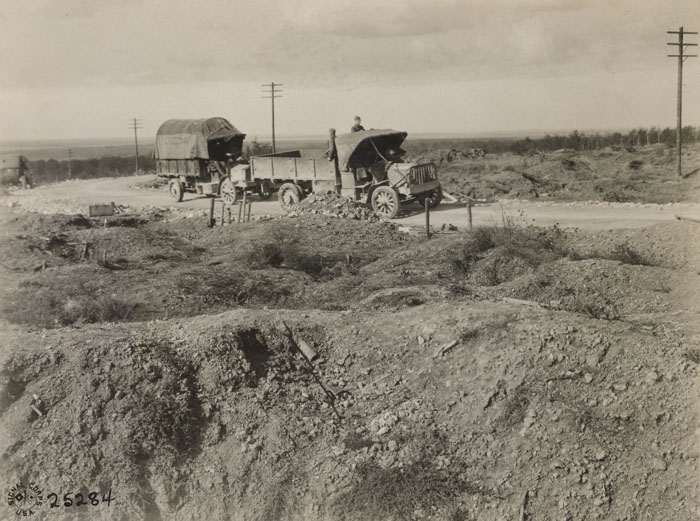
View of road constructed in three days by the engineers through the
German trenches. The stone was taken from the old buildings in
Flirey. Through this valley the germans retreated 25 kilos in 27
hours. Near Flirey.
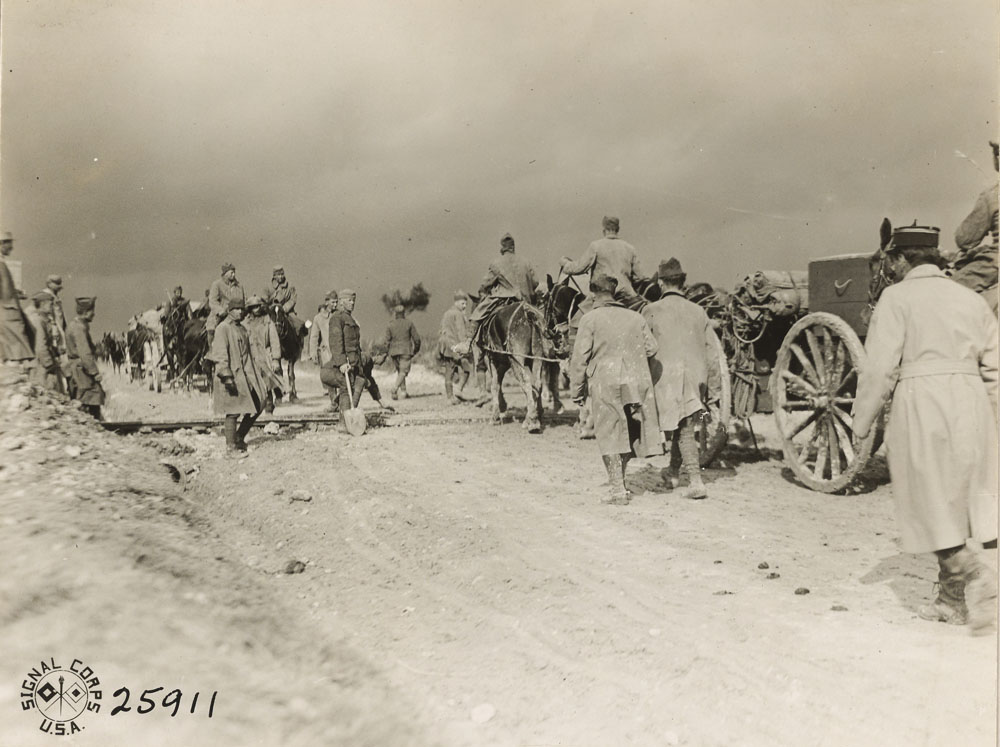
Men of Co F, 14th Engineers under 1st Lt JO Taber aiding traffic at a
RR crossing by placing boards along the railroad. Aubrecille
Avincourt. Sept 30, 1918, 2:40pm.

Engineers repairing road which was blown up by the Germans in their
retreat. Co H, 104th Eng, 83rd and 29th Divisions. Cote de
Roche near Samogneux.
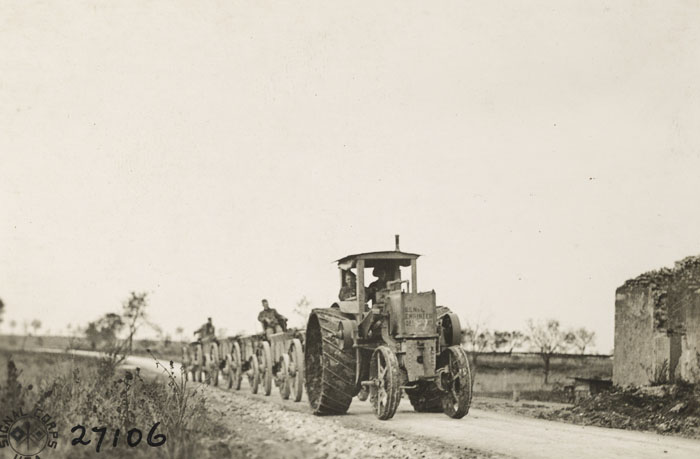
US tractor #4, hauling rock wagons during the construction of roads near Beaumont. 23rd Eng. Mandres.
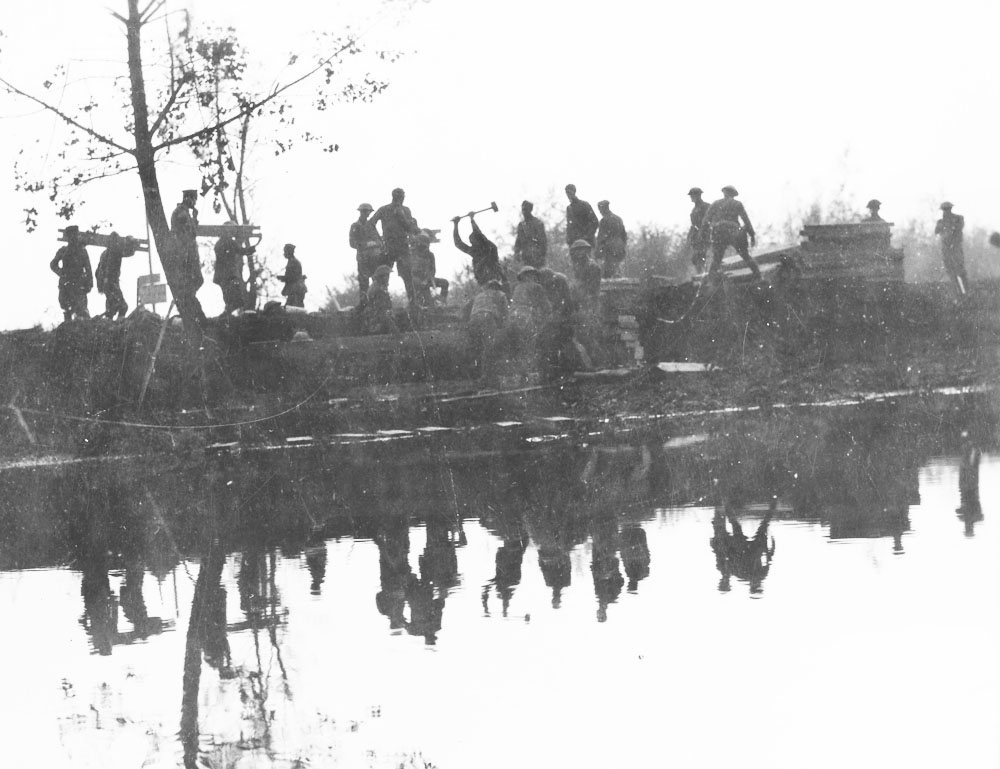
Engineers of the 1st Division at work over the Aire River, Fleville.
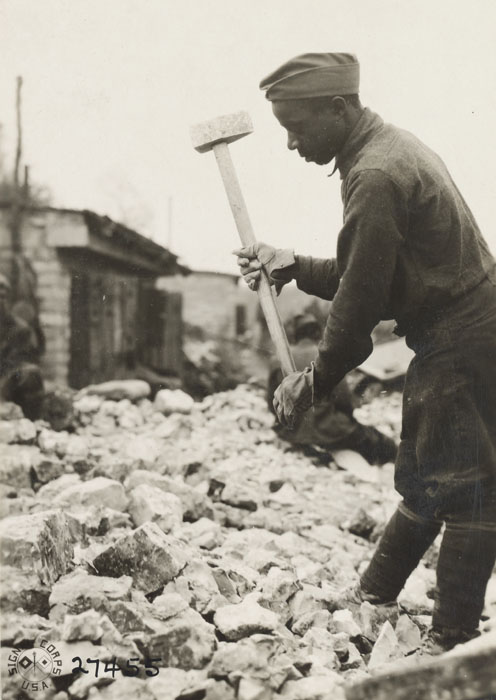
802nd Pioneer Inf breaking stone to build roads so that guns can be brought up to be placed in position. Cheppy.
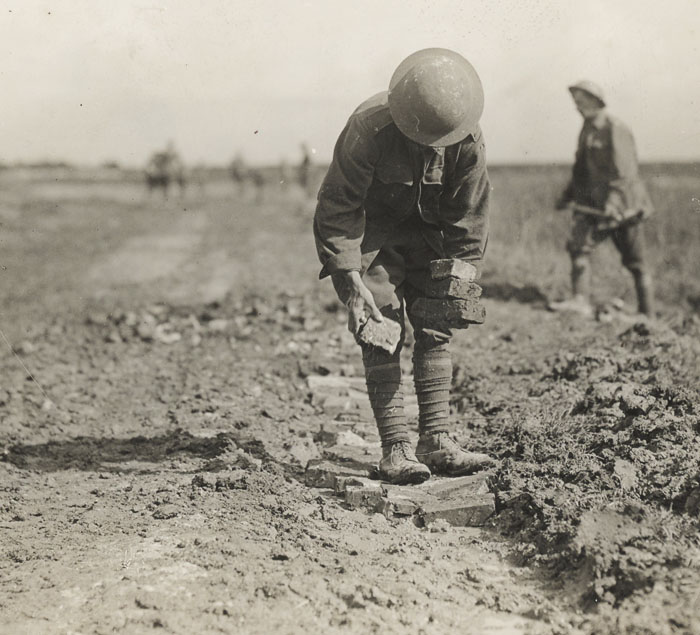
A road to the front being repaired by the 1st Australian Tunnel Co.
just east of Ronssoy. This road is shelled night and day but is
kept in repair for the purpose of bringing up supplies for the
Australian and American troops.
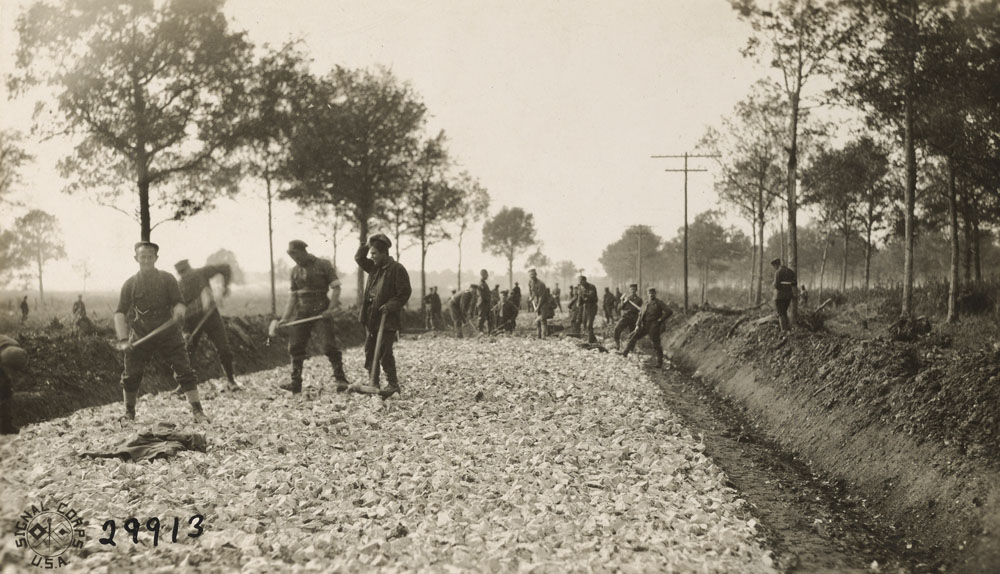
German prisoners building new road connecting Chateauroux and Montierchaume.
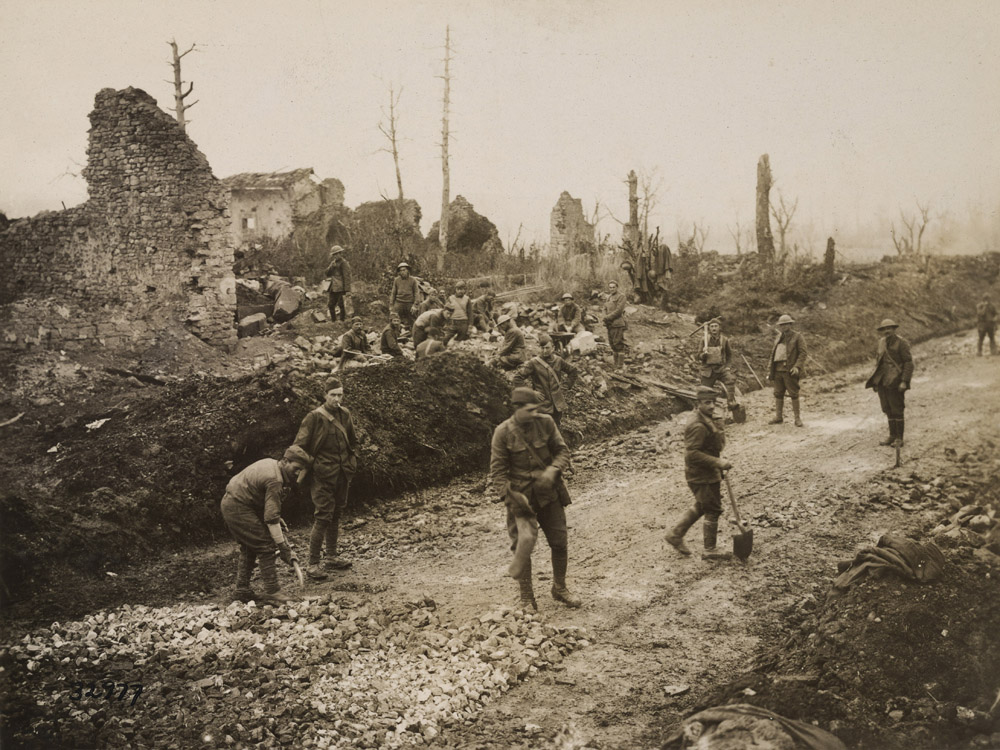
304th Engineers, 79th Div using rock from ruined town of Reigneville, to rebuild roads.
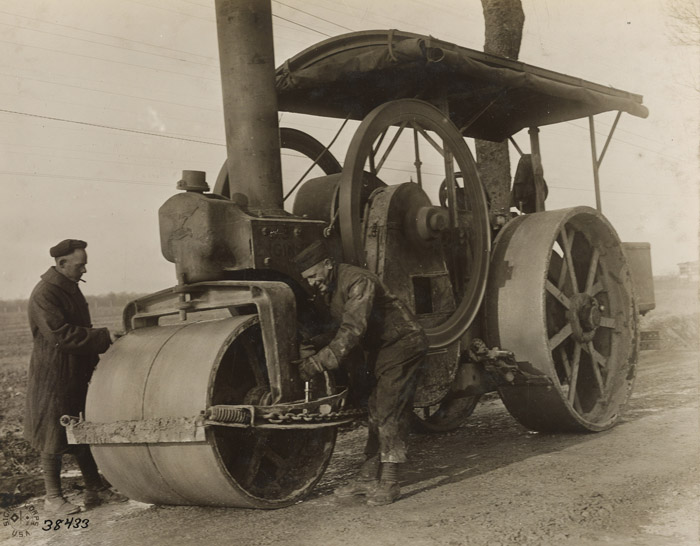
10 American roller, used by 23rd Eng on surface road work. Near Bernecourt.
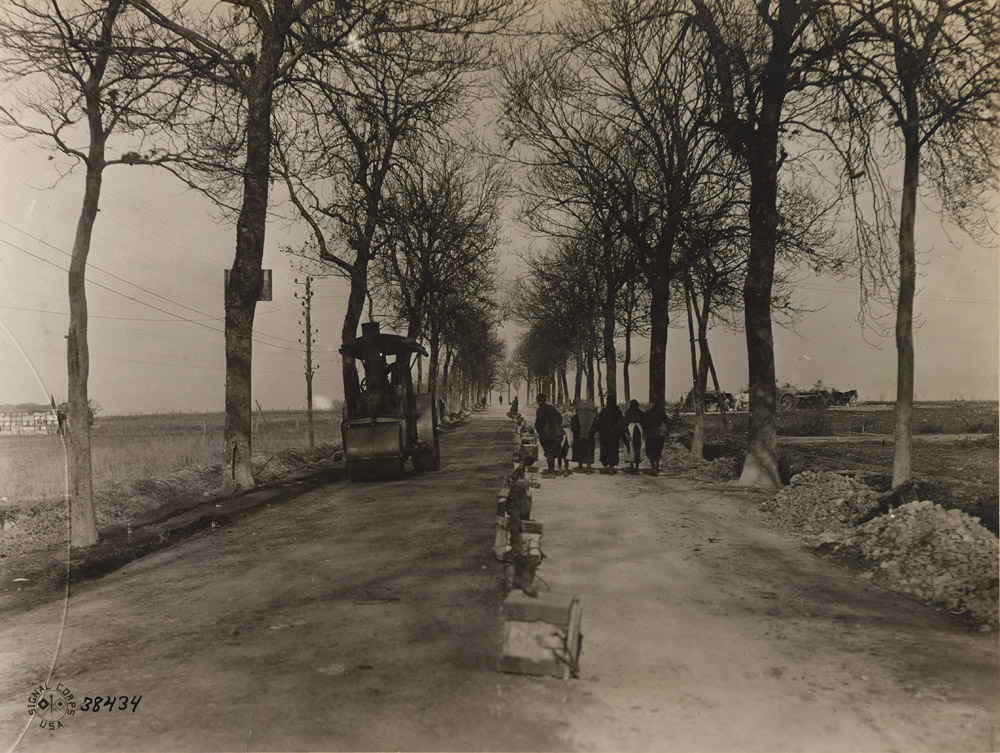
Top surface of old and new road, showing traffic open and road being regained. Near Bernecourt.

Brush gang. Near Bernecourt.
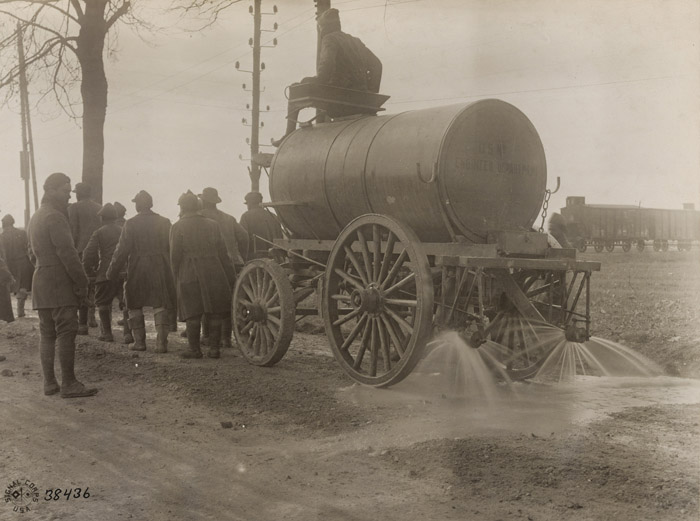
Lying top surface 200 yds crushed stone called "Binder". Natural cement. 530th Eng, 2nd Army. near Bernecourt.
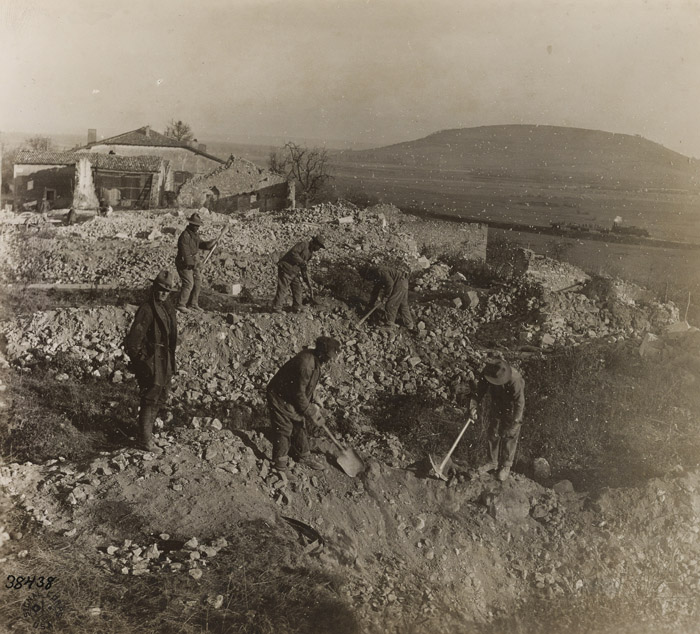
Sgt P Jackson Co C, 508th Eng, in charge of men sorting different
grades of stone for various kinds of road repair work. Woinville.

806th Eng, Co F, repairing roads. Showing methods of widening narrow roads of France. Woinville.
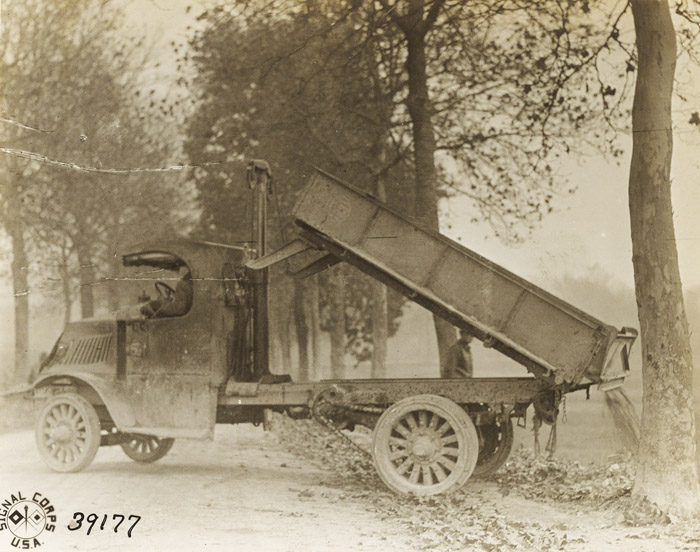
Mack truck unloading rock during repairing of roads. Co B, 23rd Engineers. Near Pagney.
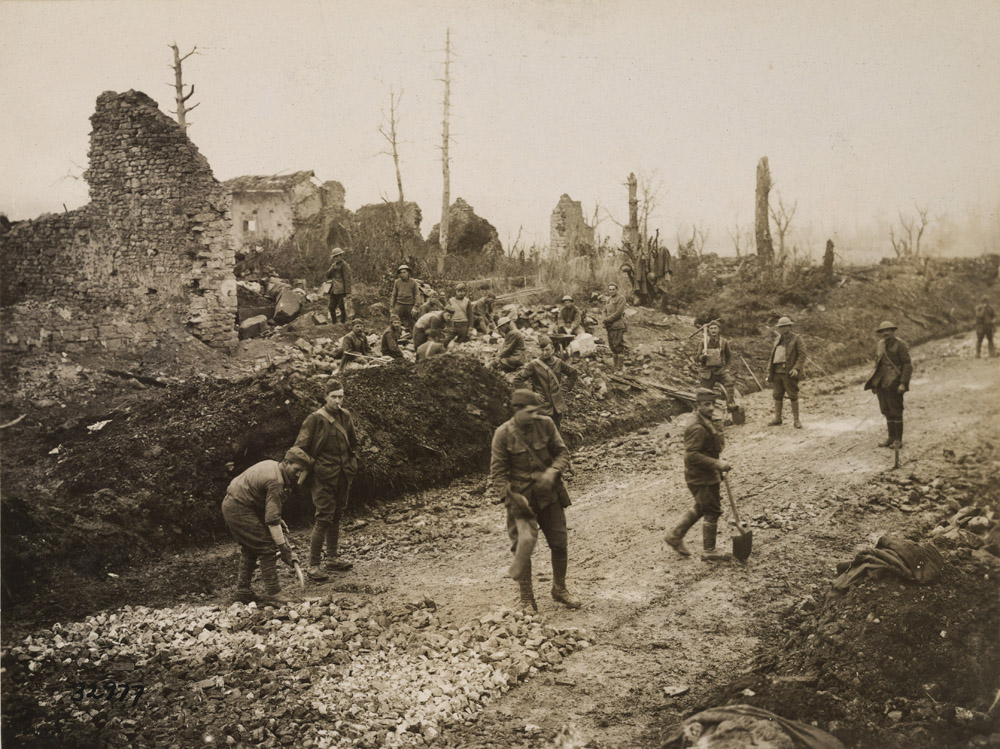
304th Eng, 79th Div, using rock from ruined town of Reigneville, to rebuild roads.
































































